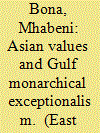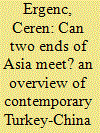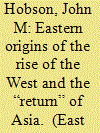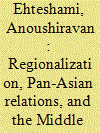|
|
|
Sort Order |
|
|
|
Items / Page
|
|
|
|
|
|
|
| Srl | Item |
| 1 |
ID:
145138


|
|
|
|
|
| Summary/Abstract |
Political elites in both the Arab Gulf and Asia have, in recent history, cultivated narratives that seek to legitimize their respective alternatives to the Western liberal-democratic model of government. In the Gulf Arab countries, this has involved highlighting the benevolence of the state through national myths of monarchical exceptionalism, while ruling elites on the Eastern side of the continent have employed the Asian values hypothesis to great effect. In both regions, exceptionalist discourses have boosted elite legitimacy in the aftermath of the Cold War – often by co-opting subaltern themes from postcolonial discourses. This study posits that the similarities between the two regional discourses are significant and that the potential is high for a future ideological convergence between them. Through its analysis of the Asia-Middle East Dialogue (AMED) – a 2004 Singaporean initiative to foster greater interregional dialogue between Eastern and Western Asia – it identifies three discursive frames that mark the existing discourse between elites on the Eastern and Western ends of the Asian continent. Focusing on the implications that these three frames would have if further adopted in Gulf Arab elite discourse, it suggests that the opportunity for discursive synergies is high as the Gulf Arab states continue to “Asianize” in the coming years.
|
|
|
|
|
|
|
|
|
|
|
|
|
|
|
|
| 2 |
ID:
145139


|
|
|
|
|
| Summary/Abstract |
China’s new Silk Road policy, titled “One Belt, One Road,” signals a proactive turn in China’s regional policy towards Central and West Asia. The policy has two dimensions: First, China aims to revitalize the old Silk Road exchange of goods, ideas, and people with trade, energy, and transportation projects. Second, armed with these new connections, China aims to redefine the territories the old Silk Road encompasses as a region in the contemporary international system. Turkey, as one of the countries at the westernmost end of the historic Silk Road, and one of the target countries of China’s new Silk Road diplomacy, welcomes the increasing economic and technological exchange with China. Establishing better contacts with China fits suitably in Turkey’s new foreign policy orientation. While the foreign policies of the two countries seem to be compatible, Turkish domestic political dynamics and public opinion hinder further engagement between the two ends of the Silk Road. The negative public opinion towards China manifests itself in the form of media coverage, protests and lobbying and, at times, it derails bilateral relations. This paper assesses the prospects for bilateral relations in the light of these developments. The paper starts with a historical analysis of Sino-Turkish relations and proceeds with various dimensions of the current relations. Then, it provides an analysis of various public opinion surveys in order to grasp the nature of the Turkish public opinion towards China, and it offers a media framing analysis in order to decipher the specific ways the image of China is constructed in Turkish public opinion. The last part of the paper discusses the domestic political actors that have a role in the perceptions and policies toward China in Turkey.
|
|
|
|
|
|
|
|
|
|
|
|
|
|
|
|
| 3 |
ID:
145136


|
|
|
|
|
| Summary/Abstract |
With the current interest in China (and India) proliferating within the Western Academy, this article claims that what we are witnessing today is not the rise but the “return” of China (and India). Many academics assume that the West has been the dominant civilization in the world economy in the last 500 years and that the current “rise” of China threatens to knock the West off its perch. However, this article provides an alternative take to this cherished axiom of Eurocentric world history by inverting the standard belief that the West pioneered modernity and then expanded outwards to remake the world. Thus, I argue not only that globalization preceded the rise of the West but that it was Eastern-led on the one hand and that it enabled the Western breakthrough into modernity on the other. This, in turn, rests on my claim that Chinese development stems back not to 1978 but to 960 ce as the Sung Dynasty emerged and subsequently undertook a quasi-industrial miracle. Moreover, between 1450/1492 and ca. 1830 China lay at the centre of the nascent global economy, fanning the integration process alongside other key non-Western regions such as India and West Asia/North Africa. And, while the West was the dominant player after ca. 1830 down to the turn of the third millennium, nevertheless, what we witness today is the return of China to the centre of the global economy whence it came.
|
|
|
|
|
|
|
|
|
|
|
|
|
|
|
|
| 4 |
ID:
145141


|
|
|
|
|
| Summary/Abstract |
This article argues that whilst the relationship between the Gulf Arab states and Asia is developing quickly, it will remain largely transactional for the foreseeable future. The relationship has intensified over the past 5 years and is manifest in increased trade, diplomatic traffic, foreign direct investment and energy relations. This has led some observers to argue that the Gulf Arab states will come to rely more upon Asian, rather than Western partners to provide for their security in the Gulf. The advent of the shale revolution and US energy independence has further underscored this line of analysis. The authors argue, however, that it is unlikely that the relationship between the Gulf Arab states and Asia will become strategic in the near future, as Asian leaders have shown no interest in guaranteeing Gulf security. They are content to bandwagon for as long as possible. Furthermore, the current security arrangement between Gulf Cooperation Council and Western powers, which has stood the test of time, looks likely to endure for decades. In spite of the apparent downturn in relations between Gulf Arab leaders and the West since the Arab Spring, both sides are committed to a long-term strategic relationship.
|
|
|
|
|
|
|
|
|
|
|
|
|
|
|
|
| 5 |
ID:
145135


|
|
|
|
|
| Summary/Abstract |
Research on the emerging links between the Middle East (West Asia) and other parts of Asia has grown considerably since late twentieth century. Indeed, the contributions to this special edition of the journal reflect some of the pioneering work taking place on pan-Asian relations encompassing new analysis of the Middle East’s links with the ‘East’—Central, South, and East Asia. The research in this field, looking back into history as well as forward, has grown in response to the changing dynamics of intra-Asian relations following the end of the Cold War in 1990 and the collapse of the Soviet Union as a Eurasian land empire just a year later. The end of bipolarity encouraged new transnational relations and further regionalization of a new world order. As multi-polarity has steadily given way to a state of non-polarity, so the veil has also been lifted on the significant economic and political ties which have grown across strategic regions. In considering strategic regions, it is contended here that Asia is home to the most dynamic of these, in terms of asset accumulation, geopolitical weight, population size, and economic prowess. But it is also significant for the volatility which appears along the fault lines of historical animosity, national security tensions, modern-day rivalries, border and resources disputes, and the strengthening of communalism and divisive role of identity politics. Moreover, the collapse of the Soviet control of much of Central Asia opened up new spaces for exchange in Asia, much encouraged by the exploitation of hydrocarbon reserves of the Soviet successor states in Asia (also Azerbaijan in the Caucasus). But, pan-Asian ties predate the post-Cold War transformations of the global system, and several Asian powers were able to negotiate mutually beneficial links soon after the Second World War. Although evidence of ancient pan-Asian relations is to be found in the Silk Road, systemic shift in our time is clearly leading to a perceptible transfer of the global economic balance Eastwards, which has brought with it the rise of energy-hungry Asian economies in the twenty-first century. Asian demand for energy has changed the complexion of Middle East-Asia relations, and pan-Asian relations in this context are today a reflection of the changing contours of the global political economy.
|
|
|
|
|
|
|
|
|
|
|
|
|
|
|
|
| 6 |
ID:
145137


|
|
|
|
|
| Summary/Abstract |
Iran-China relations have strengthened over the past decades. From an economic point of view, Iran has been an attractive destination for the Chinese businesses that are in search of new markets to expand the scope of their economic activities through trade, investment, and partnership. China has at the same time offered Iran a valuable alternative to the western economies, which gradually (and partly due to the economic sanctions imposed on Iran) decreased their level of engagement with Iran. Moreover, the relationships between China and Iran have expanded gradually to military and security cooperation. This paper will examine the development of various aspects of Sino-Iranian relations.
|
|
|
|
|
|
|
|
|
|
|
|
|
|
|
|
| 7 |
ID:
145140


|
|
|
|
|
| Summary/Abstract |
Despite its relevance and importance in the emerging global order, the partnership between South Korea and the Middle East somehow has failed to capture due attention from the pundits of geostrategy and international political economy. In the conventional discourse, the two entities have neither been characterized as natural allies nor have they been considered as equal trade partners. The engagement and interaction between South Korea and the Middle East has been limited to a story revolving around the narrative of energy security and construction assignments. In an effort to provide a more inclusive view on South Korea-Middle East relations, this paper examines the context and catalysts that are shaping the evolving partnership between the two sides and are opening new vistas for further consolidation. The paper argues that even in the current geopolitical constraints, South Korea and the Middle East have a compelling case than ever before to reignite their partnership for mutual prosperity and peace.
|
|
|
|
|
|
|
|
|
|
|
|
|
|
|
|
|
|
|
|
|